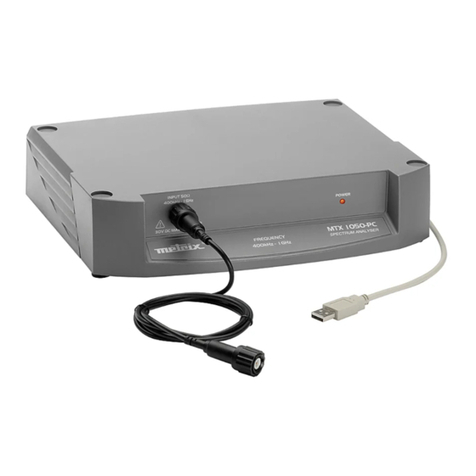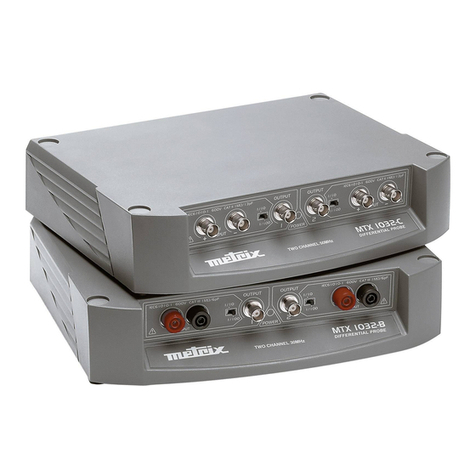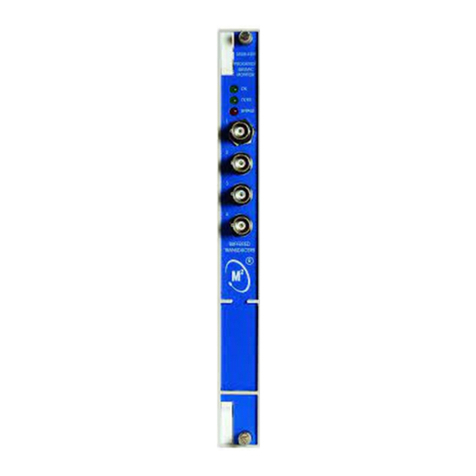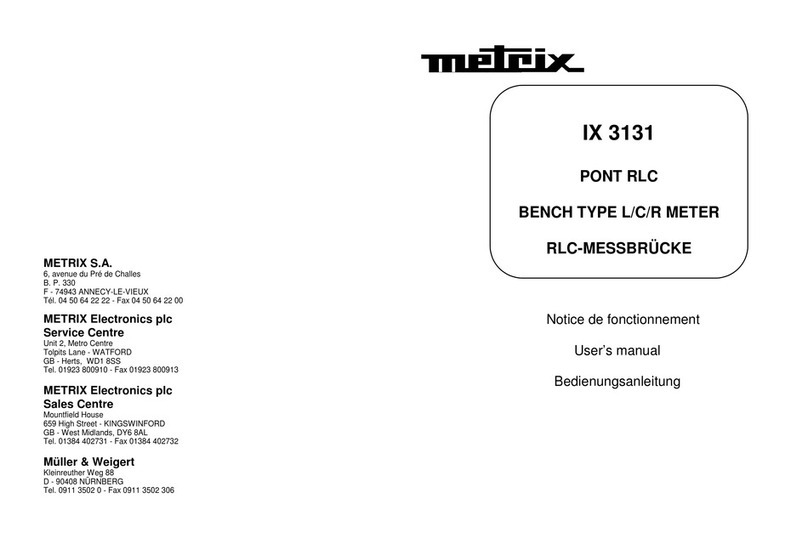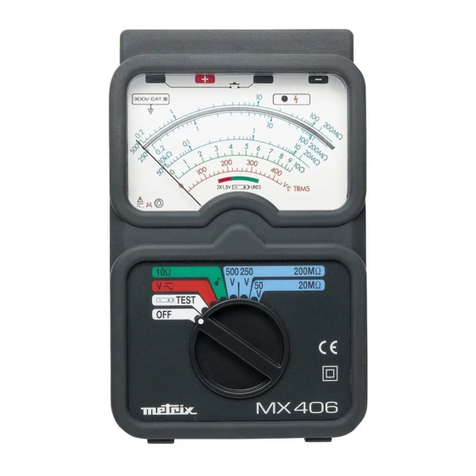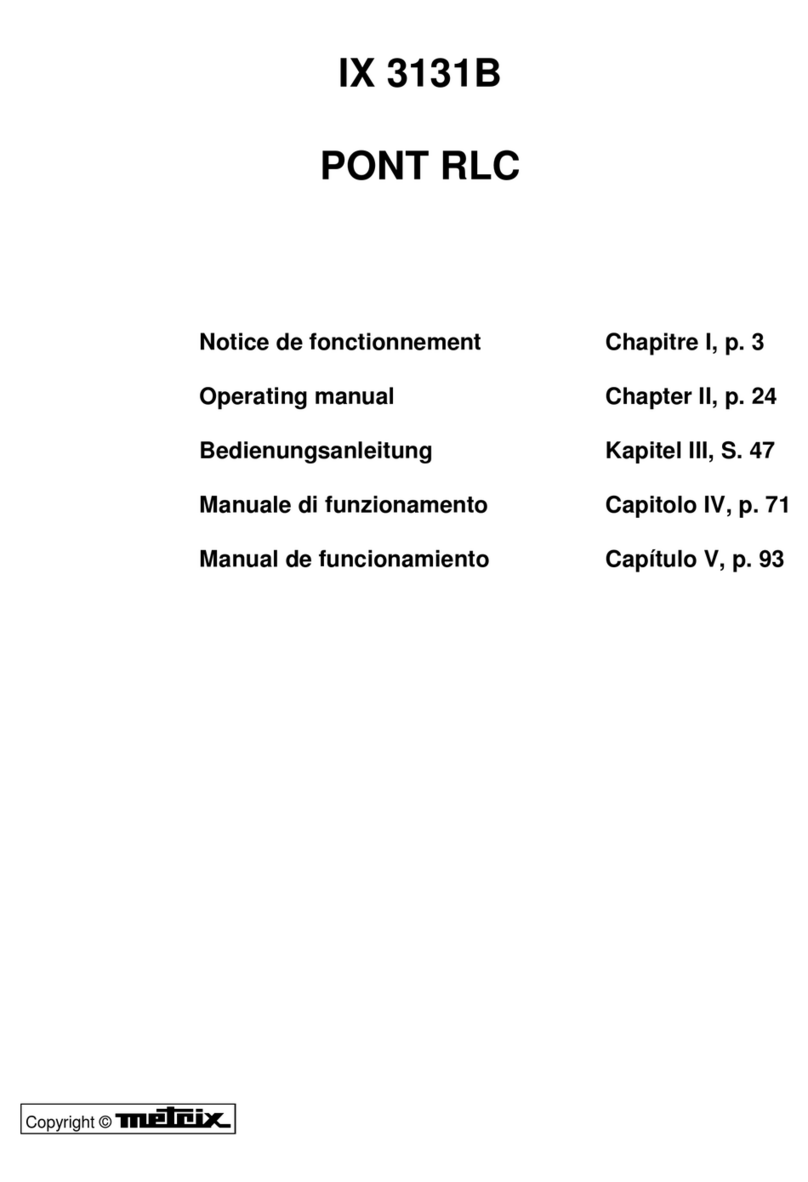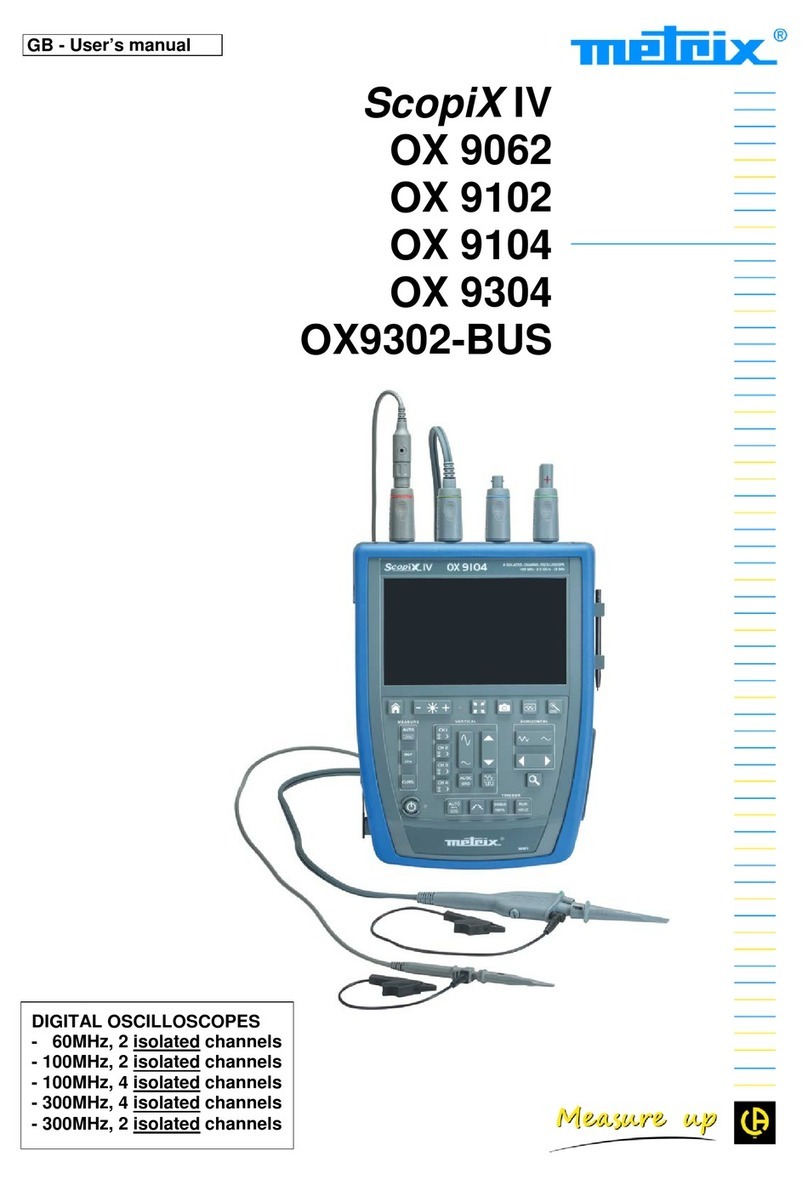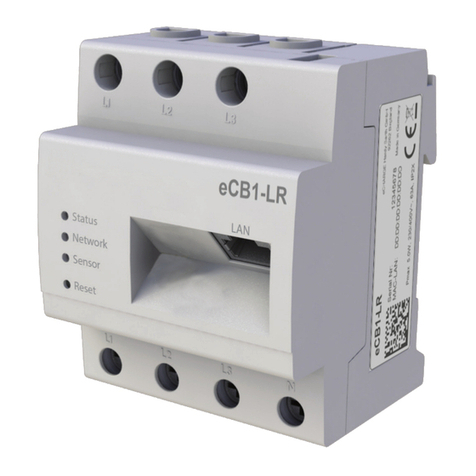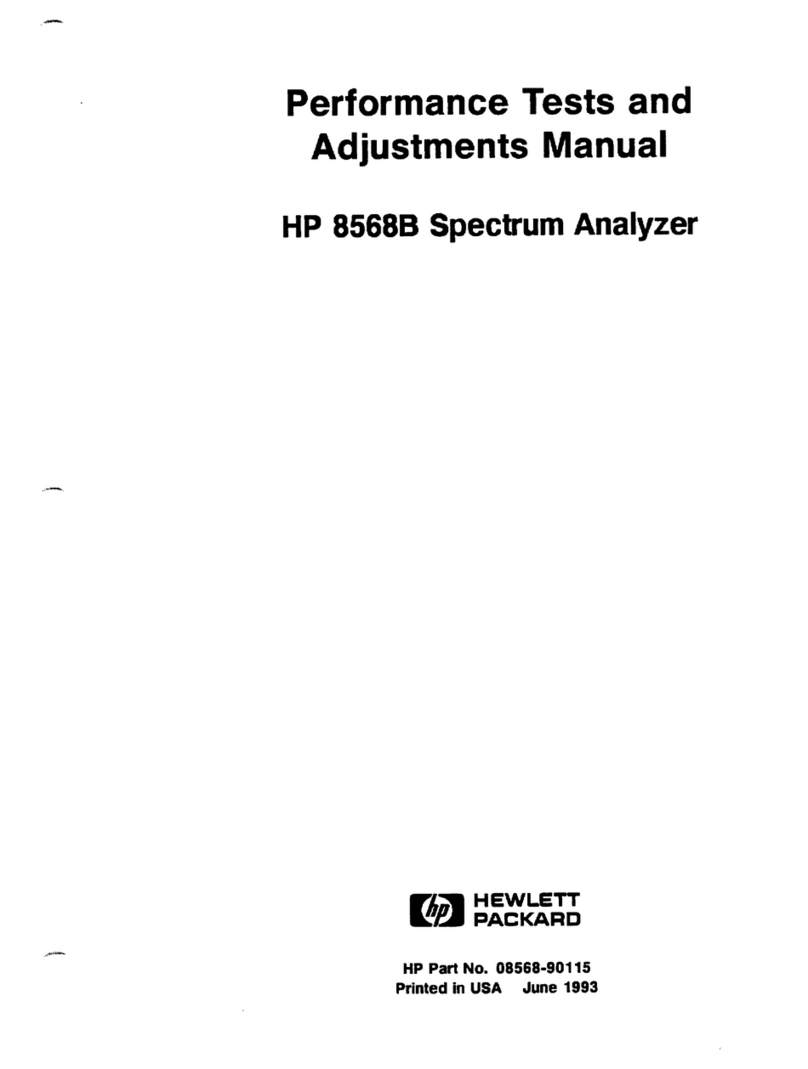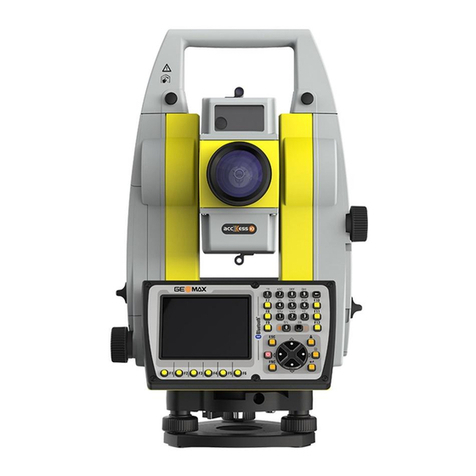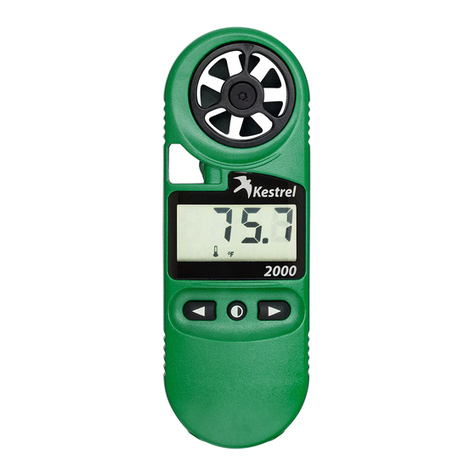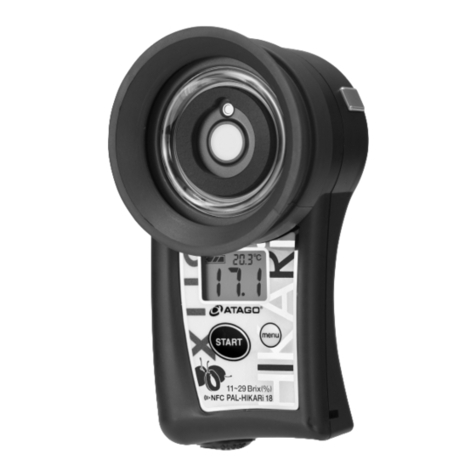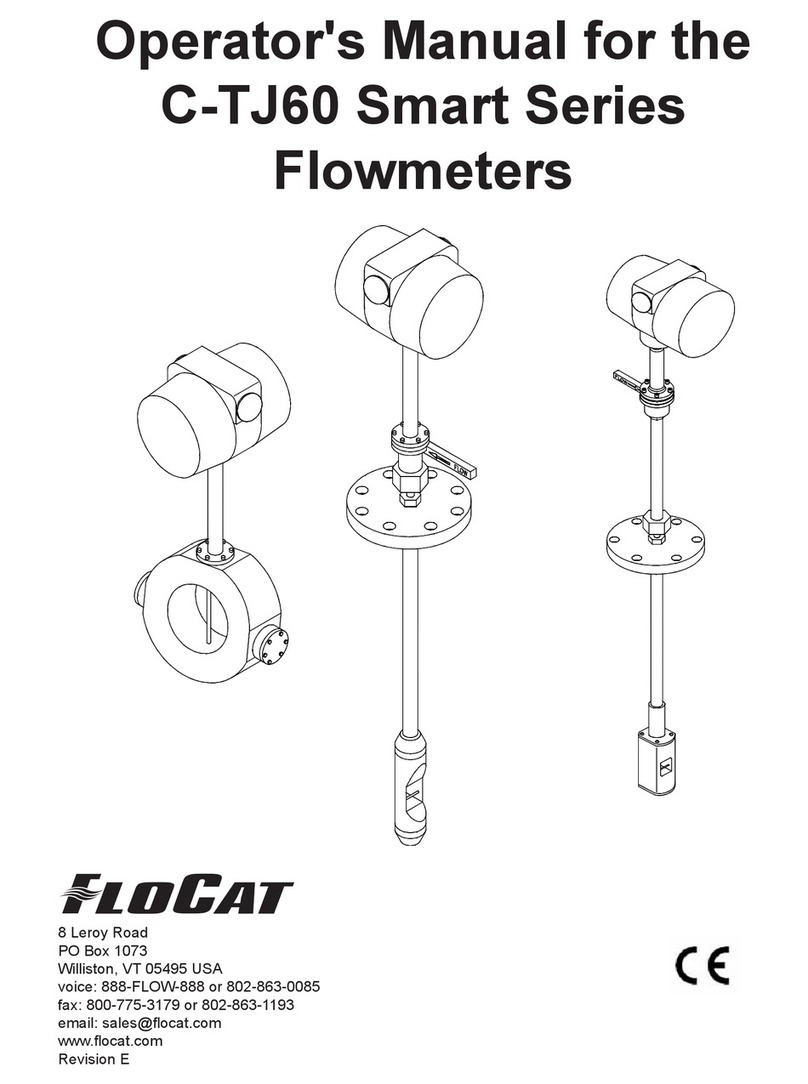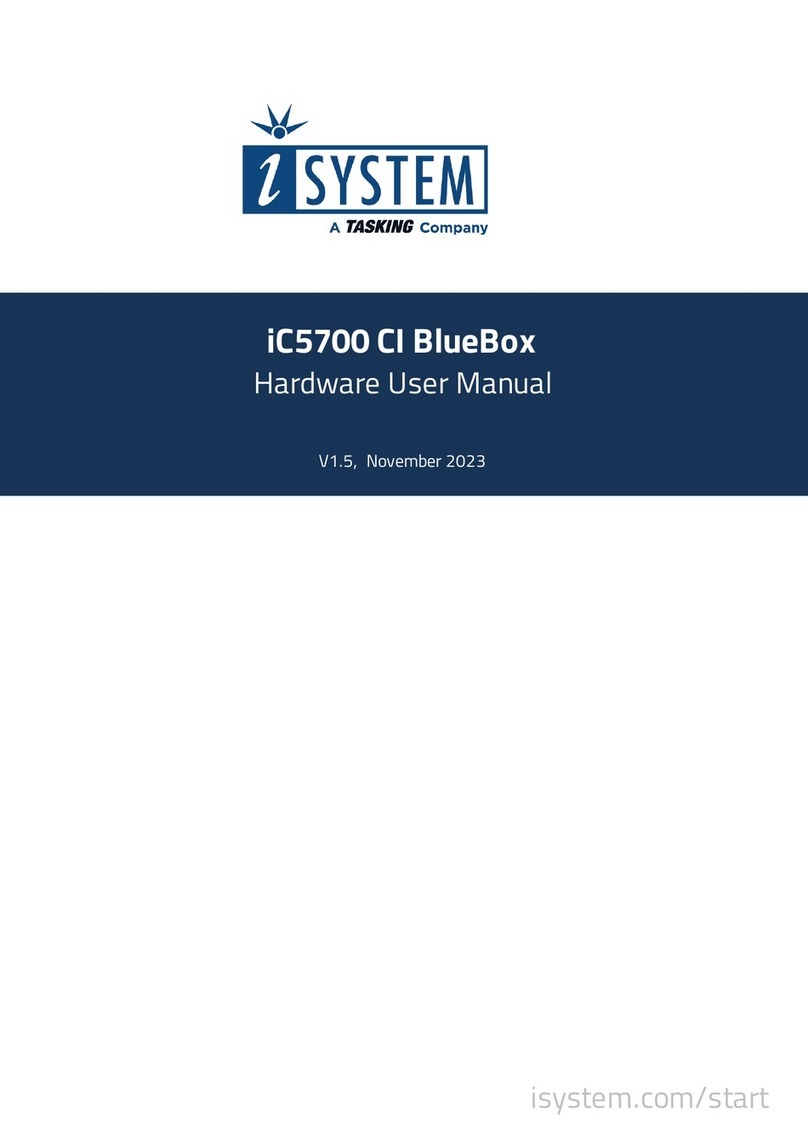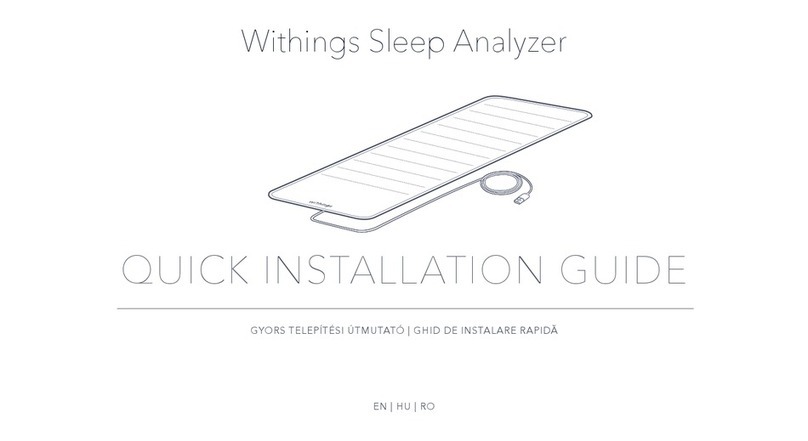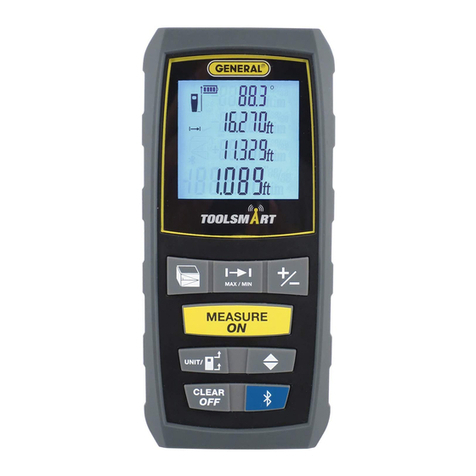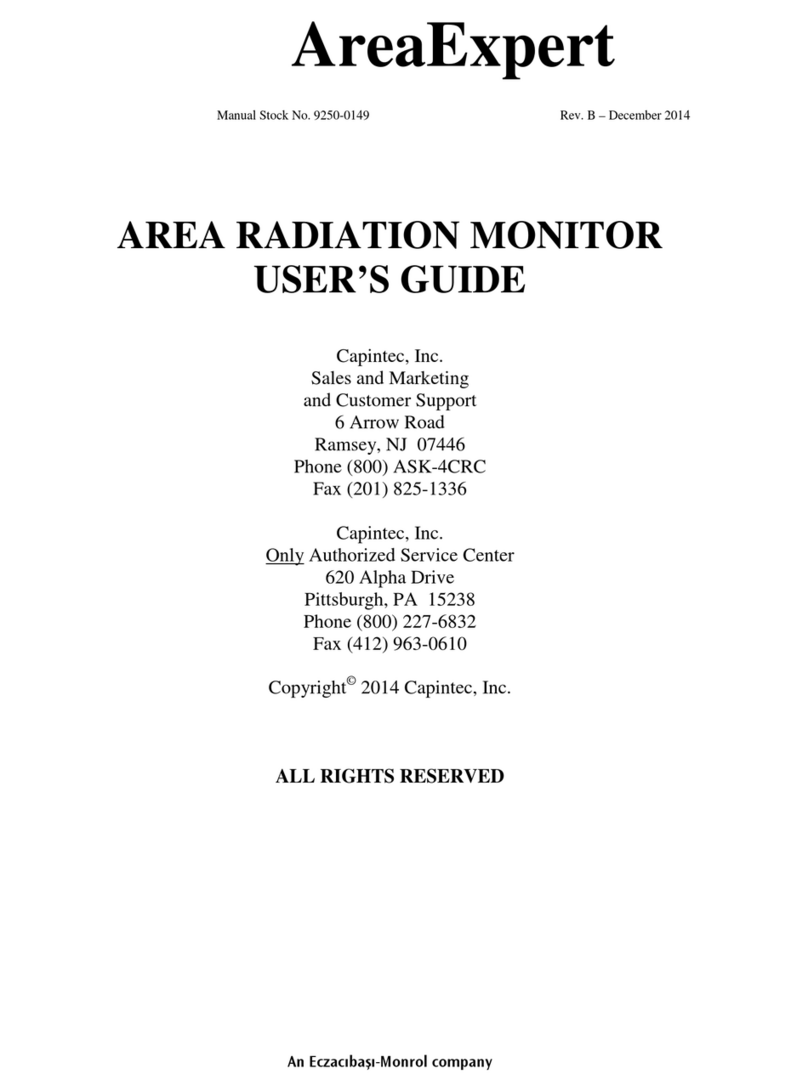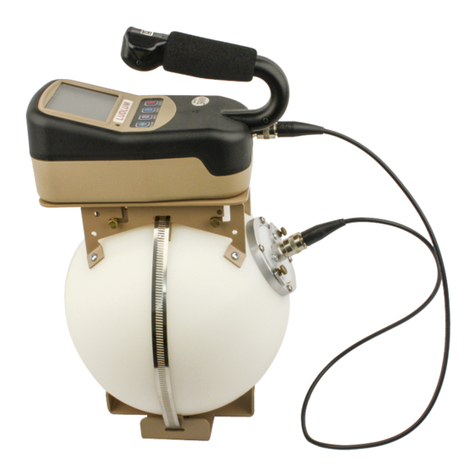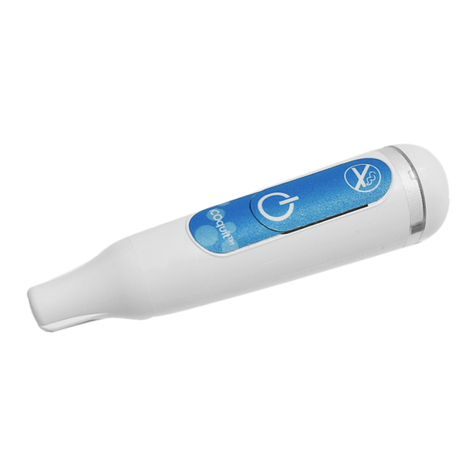Metrix MX 23 User manual

Copyright © 906129547 - Ed. 3 - 06/99
MX 23
MULTIMETRE NUMERIQUE
DIGITAL MULTIMETER
DIGITAL MULTIMETER
MULTIMETRO DIGITALE
MULTIMETRO DIGITAL
Notice de fonctionnement page 1 Chapitre
User's manual page 12 Chapter
Bedienungsanleitung Seite 24 Kapitel
Libretto d'istruzioni pagina 36 Capitolo
Manual de instrucciones página 48 Capítulo
I
II
IV
III
V

Multimètre digital portable 5000 points
+
MX 23
MX 23MX 23
MX 23
3
4
14
13
12
11
10
9
8
7
12
15
16
5
6

Chapitre I
8 Multimètre digital portable 5000 points
5. SPECIFICATIONS TECHNIQUES
5.1. Généralités
Seules les valeurs affectées de tolérance ou les limites annoncées constituent des valeurs
garanties. Les valeurs sans tolérance sont données à titre indicatif (norme NFC 42670) et
les erreurs de mesure doivent être considérées dans les conditions de température de
référence (voir § 5.2.9).
Comme tous les appareils de mesure ou d'essais, une vérification périodique est nécessaire
.
5.2. Caractéristiques
La précision est de ±[% de la lecture (L) + nombre d'unités de représentation (UR)].
{Précision : ‘’n %L + n UR’’ signifie ‘’n % de la lecture + n Unité de Représentation’’ }.
5.2.1. Tensions continues
Position du
commutateur Gammes Précision Impédance
d'entrée Protection(∗)Résolution
ADPDC 500 mVDC 10 MΩ±600 VRMS 0.1 mVDC
5 VDC 11 MΩ1 mVDC
VDC 50 VDC 0,3 %L + 2 UR ±1100 VPEAK 10 mVDC
500 VDC 10 MΩ100 mVDC
1000 VDC 1 VDC
(∗) Tension maximale permanente admissible
Nombre de points : 5 000
Sélection des gammes : automatique ou manuelle pour les
gammes 5 V, 50 V, 500 V, 1000 V
Réjection de mode commun (gamme 500 mV) : à 50 et à 60 Hz, supérieure à 120 dB
Réjection de mode série : à 50 et à 60 Hz, supérieure à 60 dB
Signal sonore intermittent avec affichage de « OL »lors d'un dépassement de gamme.
5.2.2. Tensions alternatives (AC et AC+DC)
Position du
commutateur Gammes Précision
40 Hz à 1 kHz Impédance
d'entrée Protection(∗)Résolution
5 VAC 1 mVAC
VLOW Z 50 VAC 1 %L + 2 UR 500 kΩ±600 VRMS 10 mVAC
500 VAC 100 mVAC
600 VAC 1 VAC
ADPAC+DC 500 mVAC+DC 1.5 %L + 3 UR 10 MΩ// 100 pF ±600 VRMS 0.1 mVAC+DC
5 VAC+DC 11 MΩ// 100 pF 1 mVAC+DC
VAC+DC 50 VAC+DC 1.5 %L + 2 UR ±1100 VPEAK 10 mVAC+DC
500 VAC+DC 10 MΩ// 100 pF 100 mVAC+DC
750 VAC+DC 1 VAC+DC
(∗) Tension maximale permanente admissible
Spécifications valables de 5 % à 100 % du calibre, pour un signal sinusoïdal dans la bande
40 Hz à 1 kHz.
Nombre de points : 5 000
Sélection des gammes : automatique ou manuelle pour les gam-
mes 5 V, 50 V, 500 V, 600 ou 750 V
Réjection de mode commun : à 50 et 60 Hz, supérieure à 60 dB
Erreur additionnelle en fonction du facteur crête : 1 % pour un facteur crête de 1.5 à 2
4 % pour un facteur crête de 2 à 3
Signal sonore intermittent avec affichage de « OL »lors d'un dépassement de gamme.

Chapitre I
Multimètre digital portable 5000 points 9
5.2.3. Résistances / Test de continuité
Position du
commutateur Gammes Précision Courant de mesure Protection(∗)Résolution
500 Ω0.3 %L + 3 UR 1 mA 0.1 Ω
500 Ω1 mA 0.1 Ω
5 kΩ0.3 %L + 3 UR 100 µA 1 Ω
Ω50 kΩ10 µA 600 VRMS 10 Ω
500 kΩ1 µA 100 Ω
5 MΩ0.5 %L + 3 UR 100 nA 1 kΩ
50 MΩ1 %L + 5 UR 10 nA 10 kΩ
(∗) protection électronique contre les surcharges
Nombre de points : 5 000
Sélection des gammes :automatique ou manuelle (figé en mode continuité)
Tension maximale en circuit ouvert : 4 V
Seuil de détection en mode continuité : 10 Ωà 20 Ω
Temps de réponse du mode continuité : < 1 ms
Pour les mesures dans les gammes 5 MΩet 50 MΩ, l’emploi de connexions blindées est
conseillé.
5.2.4. Capacités
"Déchargez les capacités avant toute mesure
Position du
commutateur Gammes Précision Courant de
mesure Temps de
mesure max Protection(∗)Résolution
50 nF 100 nA < 1 s 10 pF
500 nF 1 µA < 1 s 100 pF
5 µF 10 µA < 1 s 1 nF
50 µF 1 %L + 2 UR 100 µA < 1 s 600 VRMS 10 nF
500 µF 1 mA < 2 s 100 nF
5000 µF 1 mA ≈3 s/mF 1 µF
50 mF 1 mA ≈3 s/mF 10 µF
(∗) protection électronique contre les surcharges
Pour réduire l'influence des champs électromagnétiques ambiants sur la mesure, veuillez
utiliser des câbles blindés pour le calibre 50 µF.
Nombre de points : 5 000
Sélection des gammes : automatique ou manuelle
Tension maximale en circuit ouvert : 4 V
5.2.5. Fréquences
Position du
commutateur Gammes Précision Impédance
d'entrée Protection Résolution
0.62 à 5 Hz 0.0001 Hz
5 à 50 Hz 0.001 Hz
FREQ 50 à 500 Hz 0.03 %L + 1 UR 10 MΩ600 VRMS 0.01 Hz
500 à 5 kHz 0.1 Hz
5 à 50 kHz 1 Hz
50 à 500 kHz 0.05 %L + 1 UR 10 Hz
Nombre de points : 50 000
Sélection des gammes : automatique
Bande de fréquence Sinus Carré
10 Hz à 100 kHz 100 mVeff. 200 mVcc
100 kHz à 500 kHz 1 Veff. 1 Vcc
Sensibilité :

Chapitre I
10 Multimètre digital portable 5000 points
5.2.6. Mesure de tension de seuil diodes
Tensions mesurables : 0 à 1.999 V
Courant de mesure : 1 mA ±20 %
Résolution : 1 mV
Protection : 600 VRMS
5.2.7. Sécurité
CEI 61010-1 + A1 + A2, 1995
Isolation : classe 2
Degré de pollution : 2
Utilisation à l'intérieur, altitude < 2000 m
Catégorie de surtension des entrées : CAT III 600 V max. par rapport à la terre
5.2.8. Informations générales
Caractéristiques mécaniques
Dimensions : 170 x 80 x 35 mm
Masse (avec pile) : 285 g
Boîtier et circuit : matières auto-extinguibles
Colisage
Dimensions : 230 x 155 x 65 mm
Masse : 385 g
Alimentation
Alimentation requise : 1 pile de type alcaline 9 V (6LF22)
Indication de pile déchargée : BAT s'affiche quand la tension fournie
par la pile est trop faible.
Autonomie typique de la pile : 500 heures environ en mode VDC
Affichage
Réalisé par un afficheur à cristaux liquides comportant :
- un affichage 50 000 points + signe (hauteur des chiffres : 11 mm)
- un affichage analogique 34 barres (bargraph)
- des unités adaptées à chaque type de mesure
- des indicateurs de modes enclenchés (mémorisation, ranging, ...)
- un indicateur de pile déchargée
Cadence de mesure
Affichage numérique : 2 mesures par seconde
Bargraph : 20 mesures par seconde
5.2.9. Environnement
Température de référence : 23°C ± 5°C
Température limite d'utilisation : - 5°C à 45°C
Température de fonctionnement : - 10°C à 55°C
Température de stockage : - 20°C à 70°C
Coefficient de température : max. 0,1 x (précision) / K
•erreur additionnelle en Ω: 50 UR de -5°C à 0°C
•sensibilité fréquence : max. 0,3 x (sensibilité) / K
Humidité relative : 0 à 80 % de 0°C à 35°C
(70 % max. pour 5 / 50 MΩ)
0 à 70 % de 35°C à 50°C
Etanchéité : IP 50
Influence max. en présence de champs électro-
magnétiques à 3 V/m selon EN 61000-4-3, 1995 : 3 %

Chapitre I
Multimètre digital portable 5000 points 11
5.2.10.CEM
Cet appareil a été conçu conforme aux normes CEM en vigueur et sa compatibilité a été
testée conformément aux normes suivantes :
•Emission selon EN 50081-1, 1992
•Immunité selon EN 50082-1, 1997
Ce produit est conforme aux prescriptions de la directive européenne basse tension
73/23/CEE et à la directive CEM 89/336/CEE amendées par 93/68/CEE.
5.3. Accessoires
5.3.1. Livrés avec le multimètre
1 jeu de cordons - pointes de touche de sécurité AG1063
1 pile 9 V 6LF22 AL0042
1 notice de fonctionnement 906129547
1 gaine de protection élastomère AE0237
5.3.2. Livrés en option
Sondes
THT 3 kVAC/DC HT0203
THT 30 kVDC HT0212
Thermocouple type K, 1 mV/°C, usage général et surface, -25°C à +350°C HK0210N
Tachymètre optique, 100 t/mn à 60 000 t/mn HA1237
Pinces de courant
Calibre 200 AAC, 1 AAC/1 mVAC, ∅câble maxi 20 mm, sortie par douilles AM0014N
Calibre 200 AAC, 1 AAC/10 mVAC, ∅câble maxi 20 mm, sortie par douilles AM0016N
Calibre 600 ADC, 600 AAC, ∅câble maxi 30 mm, sortie par douilles AM0600N
Calibre 1000 ADC, 600 AAC, ∅câble maxi 43 mm, sortie par douilles AM1000N
Shunts
30 ADC / 300 mV, ±0,5 % HA0170
50 ADC / 50 mV, ±0,5 % HA0512
300 ADC / 30 mV, ±0,5 % HA0300
Divers
Etui de transport AE0190

Chapter II
12 5000-count portable digital multimeter
USER'S MANUAL
CONTENTS
1. GENERAL INSTRUCTIONS..................................................................................................... 13
1.1. Precautions and safety measures......................................................................................13
1.1.1. Preliminary...................................................................................................................13
1.1.2. During use...................................................................................................................13
1.1.3. Symbols....................................................................................................................... 14
1.1.4. Instructions.................................................................................................................. 14
1.2. Protection devices..............................................................................................................14
1.3. Safety devices....................................................................................................................15
1.4. Warranty ............................................................................................................................15
1.5. Maintenance and metrological verification..........................................................................15
1.6. Unpacking - Repackaging.................................................................................................. 15
2. DESCRIPTION ......................................................................................................................... 16
2.1. Selector switch...................................................................................................................16
2.2. Keypad...............................................................................................................................16
2.3. Display ............................................................................................................................... 16
2.4. Power supply...................................................................................................................... 16
2.5. Input terminals.................................................................................................................... 16
3. GETTING STARTED ................................................................................................................ 17
3.1. Connecting the test leads...................................................................................................17
3.2. Switching on the instrument ............................................................................................... 17
3.3. Switching off the instrument ...............................................................................................17
3.4. Special configuration..........................................................................................................17
3.5. Multimeter maintenance.....................................................................................................17
3.5.1. Fuse self-test............................................................................................................... 17
3.5.2. Battery self-test............................................................................................................17
3.5.3. Replacing the battery or the fuse.................................................................................18
3.5.4. Cleaning ...................................................................................................................... 18
3.5.5. Storage........................................................................................................................ 18
4. FUNCTIONAL DESCRIPTION.................................................................................................. 19
4.1. RANGE / AC+DC key.........................................................................................................19
4.1.1. ADPDC / ADPAC+DC Position.................................................................................... 19
4.2. MEM / AUTO MEM key..........................................................................................................
5. TECHNICAL SPECIFICATIONS............................................................................................... 20
5.1. General.............................................................................................................................. 20
5.2. Characteristics ...................................................................................................................20
5.2.1. DC voltages.................................................................................................................20
5.2.2. AC voltages (AC and AC+DC).....................................................................................20
5.2.3. Resistance / Continuity test..........................................................................................21
5.2.4. Capacitance................................................................................................................. 21
5.2.5. Frequencies.................................................................................................................21
5.2.6. Diode threshold voltage measurement.........................................................................22
5.2.7. Safety .......................................................................................................................... 22
5.2.8. General information..................................................................................................... 22
5.2.9. Environment................................................................................................................. 22
5.2.10. EMC........................................................................................................................... 23
5.3. Accessories........................................................................................................................ 23
5.3.1. Supplied with the multimeter........................................................................................ 23
5.3.2. Optional....................................................................................................................... 23

Chapter II
5000-count portable digital multimeter 13
1. GENERAL INSTRUCTIONS
You have just acquired a portable digital multimeter and we thank you for your confidence.
This instrument complies with the specification of IEC 61010-1 + A1 + A2, 1995, publication
concerning safety requirements for electronic measuring apparatus. To get the best service
from this instrument, read carefully this user's manual and respect the detailed safety
precautions.
The contents of this manual must not be reproduced in any form whatsoever without our
consent.
1.1. Precautions and safety measures
1.1.1. Preliminary
- This device can be used for measurements on category ΙΙΙ installations, for voltages
never exceeding 600 V (AC or DC) relative to the earth.
- Definition of overvoltage categories (cf. publication IEC 664-1) :
CAT I: The circuits of CAT I are protected by measures limiting transient
overvoltages to appropriate low level.
Example : protected electronic circuits
CAT II : The circuits of CAT II are power supply circuits of appliances or portable
equipment with transient overvoltages of an average level.
Example : appliances and portable equipment
CAT III : The circuits of CAT III are power supply circuits of power equipment with
important transient overvoltages.
Example : fixed installation or industrial equipment
CAT IV :The circuits of CAT IV may comprise very important transient
overvoltages.
Example : primary supply level
∗When using this multimeter, the user must observe all normal safety rules
concerning:
- protection against the dangers of electric current.
- protection of the multimeter against misuse.
∗For your own safety, only use the measuring probes which have been delivered with
the instrument : they conform to the IEC 61010-1 + A1 + A2, 1995, safety standard.
Before use, check that they are in good working condition.
1.1.2. During use
∗Test equipment risk assessment : Users of this equipment and or their employers
are reminded that Health and Safety Legislation require them to carry out a valid
risk assessment of all electrical work so as to identify potential sources of electrical
danger and risk of electrical injury such as from inadvertent short circuits. Where
the assessment show that the risk is significant then the use of fused test leads
constructed in accordance with the HSE guidance note GS38 "Electrical Test
Equipment for use by Electricians" should be used.

Chapter II
14 5000-count portable digital multimeter
∗Never exceed the protection limit values indicated in the specifications for each type
of measurement.
∗When the multimeter is linked to measurement circuits, do not touch unused
terminals.
∗When the scale of the value to be measured is unknown, check that the scale initially
set on the multimeter is the highest possible or, wherever possible, choose the
autoranging mode.
∗Before changing functions, disconnect the test leads from the circuit under test.
∗In TV repair work, or when carrying out measurements on power switching circuits,
remember that high amplitude voltage pulses at the test points can damage the
multimeter. Use of a TV filter will attenuate any such pulses.
∗Never perform resistance or continuty measurements on live circuits.
1.1.3. Symbols
Symbols used in this manual and on the instrument :
CAUTION : Refer to the instruction manual.
Incorrect use may result in damage to the device or its
components.
pDANGER : High voltage, risk of electric shock
Earth
1.1.4. Instructions
∗Before opening the instrument, always disconnect from all sources of electric
current and make sure not to be loaded with static electricity, which may destroy
internal components.
∗Fuse must be replaced with fuse of the same rating and type.
∗Any adjustment, maintenance or repair work carried out on the multimeter while it
is live should be carried out only by appropriately qualified personnel, after
having taken into account the instructions in this present manual.
A "qualified person" is one who is familiar with the installation, construction and
operation of the equipment and the hazards involved. He is trained and
authorized to energize, de-energize circuits and equipment in accordance with
established practices.
∗When the instrument is open, remember that some internal capacitors can retain
a dangerous potential even after the instrument is powered down.
∗If any faults or abnormalities are observed, take the instrument out of service and
ensure that it cannot be used until it has been checked out.
∗It is recommended to remove the battery from the instrument if not used.
1.2. Protection devices
This instrument is fitted with various protection devices :
∗Varistor protection for limiting transients of over 1100 V at the VΩterminal,
particularly 6 kV pulse streams as defined in French standard IEEE 587.

Chapter II
5000-count portable digital multimeter 15
∗A PTC (positive temperature coefficient) resistor protects against permanent
overvoltages of up to 600 V during resistance, capacitance, continuity and diode
test measurements. This protection is reset automatically after overload.
∗The fuse provides protection while measuring Ωand testing diodes.
∗An IP protection rating of 50.
1.3. Safety devices
∗The battery unit cannot be accessed without first disconnecting the measuring
leads.
∗When measuring voltages above 24 V, the sign blinks
pon the display and an
intermittent audible signal warns the user.
∗If the maximum range is repeatedly exceeded, an intermittent audible signal warns
the user in VLOW Z, VAC+DC, VDC,ADPDC, ADPAC+DC functions.
1.4. Warranty
This equipment is warranted against any defects of manufacture or materials according to
the general conditions of sale.
During the warranty period (3 years), defective parts will be replaced, the manufacturer
reserving the right to repair or replace the product. In the event of the equipment being
returned to the after sale department or to a local agency, carriage to the centre shall be
payable by the customer. The warranty does not cover the following :
1. Repairs necessitated by misuse of the equipment or use in association with incompatible
equipment.
2. Modification of the equipment or any related software without the explicit authorization of
the manufacturer.
3. Repairs necessitated by attempts to repair or maintain the product made by a person not
approved by the manufacturer.
4. Adaptation to a specific application not provided for in the specifications of the equipment
or the user manual.
5. Damage after a drop, a shock or flooding.
1.5. Maintenance and metrological verification
Return your instrument to your distributor for any work to be done within or outside the
guarantee.
1.6. Unpacking - Repackaging
This equipment has been fully checked out mechanically and electrically before shipping.
All precautions have been taken to ensure that the instrument arrives at its destination
undamaged. However, it is advisable to carry out a rapid check for damage sustained in
shipping. If there is any evidence of damage, make this known immediately to the
shipper.
!Should you need to return the multimeter, preferably use the original packaging and
indicate the reasons as clearly as possible on an accompanying note.
"Our products are patented in FRANCE and internationally and the logotypes are
registered. We reserve the right to modify specifications and prices as required by
technological improvements.

Chapter II
16 5000-count portable digital multimeter
2. DESCRIPTION
This compact multimeter is a self-contained with an appropriate mechanical construction,
enables hand-held version, with a protective elastomer case. This casing is sealed.
It is designed for a high degree of user safety, maximum protection and unrivalled
performance.
2.1. Selector switch
This multimeter is a standalone, hand-held professional measuring instrument, capable of
measuring the following quantities (accessed by the ten-position rotary selector switch) :
∗AC voltages with AC (or RMS) capacitive coupling (Input impedance : 500 kΩ)
∗AC voltages with AC+DC (or TRMS) direct coupling
∗DC voltages
∗DC / AC+DC voltages, range 500 mV
∗resistance values
∗continuity (with beeper)
∗capacitance
∗diode threshold voltage
∗frequencies
2.2. Keypad
A two-key keypad lets you :
∗select the autoranging mode (RANGE/ AC+DC key)
∗store a value (MEM key)
∗select a function derived from the main function, or switch on the multimeter again
after it has been shut down automatically (RANGE/ AC+DC key)
2.3. Display
This multimeter display provides :
∗perform 5 000-point measurements (50 000-point Hz-measurements)
∗function indicator (V, AC+DC, F, Hz, , Ω, , AUTO, MEM) and
multiplicator (n, µ, m, k, M)
∗battery discharged indicator BAT : approximately 12 hours of operation
∗clearly legible figures (11 mm high)
∗an analogue readout of the parameter being measured through a 34-segment
bargraph.
2.4. Power supply
This multimeter is powered by a standard 9 V battery (6LF22) which provides
approximately 500 hours of operation (on function VDC).
2.5. Input terminals
Measurements are performed using two measuring leads supplied with the instrument
connected to input terminals 1, 2 as indicated in section 3.1.

Chapter II
5000-count portable digital multimeter 17
3. GETTING STARTED
3.1. Connecting the test leads
Connect the black lead to the COM socket and connect the red lead to the other socket.
3.2. Switching on the instrument
The selector switch is on the OFF position.
Turn the selector switch to the required function.
All segments of the display come on for a few seconds. The instrument is then ready for
measurements.
3.3. Switching off the instrument
The instrument can be switched off manually by returning the selector switch to the OFF
position, or automatically after approximately half an hour if no key is pressed or the
switch is not operated.
"Note For user safety, automatic shutdown is disabled when a measured
magnitude (voltage) present at the input exceeds dangerous level
(indicator displayed).
3.4. Special configuration
To adapt the configuration of the instrument to the measurement environment, the user
choose 50 Hz or 60 Hz rejection :
Switch on with the rotary switch while holding down the MEM key. The selection is
reversed from the last configuration, is displayed for two seconds and remains backed
up in non-volatile memory.
3.5. Multimeter maintenance
3.5.1. Fuse self-test
This check can be carried out with the multimeter in use without opening up the casing.
10 A fuse : set the rotary switch to the position and short-circuit the COM and VΩ
sockets. The display should read approx. 0.001 V. If the digital display indicates an
overflow « .OL ». The fuse is blown.
3.5.2. Battery self-test
When the BAT indication appears on the display, the instrument still has approximately 12
hours of operation, but specifications can no longer be guaranteed.
Replace the battery.

Chapter II
18 5000-count portable digital multimeter
3.5.3. Replacing the battery or the fuse
!Caution ! Disconnect test leads from any circuit under test, turn the meter off
and remove test leads from the input terminals .
Use the following procedure :
1 - Disconnect test leads from any inputs terminals.
2 - Using a appropriate tool, make slide the case bottom of the instrument.
3 - Replace the battery or the fuse.
4 - Replace the immovable part.
!Fitting the fuse :
This fuse is correctly fitted ; this one is not.
3.5.4. Cleaning
Clean the instrument using a damp cloth and soap. Never use abrasive or solvents.
3.5.5. Storage
To guarantee the measurement accuracy, after a long period storage in extreme
environment conditions, wait enough time for the instrument to acclimatise to the working
environment conditions (see environment specifications).
6LF22 9 V
BATTERY
HBC 10 A 50 kA
600 V FUSE
Fuse must be
replaced by fuse of
the same rating and
t
yp
e.

Chapter II
5000-count portable digital multimeter 19
4. FUNCTIONAL DESCRIPTION
4.1. RANGE / AC+DC key
The RANGE key is operative in following posiTIons of the selector switch :
VLOW Z, VAC+DC, VDC, Ω, .
This key makes it possible :
•In AUTO (Autoranging) mode to switch to MANUAL mode (short press).
•In MANUAL mode, to select the next range (short press) or return to AUTO mode
(long press), the AUTO sign appears on the display.
This can be used to switch on the multimeter again after an automatic shutdown. The
AC+DC key can be used to access secondary functions associated with the selector
switch to the ADPDC positions (ADPAC+DC).
4.1.1. ADPDC / ADPAC+DC Position
This function is adapted for accessories with mV output.
4.2. MEM / AUTO MEM key
Short press (MEM) : Fixes the display on the current value. A second short press returns
the multimeter to normal mode. The MEM sign appears on the display.
The MEM mode is avaible on all measurement.
Long press (AUTO MEM) : Accesses or quits the “autostore” mode.
The MEM sign blinking on the display.
Affected ranges : VLOW Z, VAC+DC, VDC, ADPDC, ADPAC+DC
Autostore
Set the probes on the point to be measured. An audio signal indicates if the measurement
is stable. When you remove the probes, a second audible signal indicates that this stable
value displayed has been stored.
"The bargraph remains active during the "autostore” and display MEM mode.
Pressing this key when switching on the instrument enables the selection of a rejection of
50 or 60 Hz. The selection is reversed from the last configuration. It is displayed for 2
secs. and remains backed up in non-volatile memory.
ADPAC+DC
AC+DC voltage measurement (TRMS)
(Range 500 mVAC+DC)
ADPDC
DC voltage measurement
(Range 500 mVDC)
AC+DC key
AC+DC key
The AC+DC sign appears
on the display.

Chapter II
20 5000-count portable digital multimeter
5. TECHNICAL SPECIFICATIONS
5.1. General
Only the values assigned tolerances or given limits are guaranteed values. Values without
tolerances are given for information only, without guarantee (standard NFC 42670). The
measurement errors must be considered in an environment of reference temperature
(refer to § 5.2.11).
It is essential that all measuring instruments are regularly calibrated.
5.2. Characteristics
Accuracy is ±[% reading (R) + number of digits (D)] at the reference temperature.
{Accuracy : ‘’n %R + n D’’ means ‘’n % of the reading + n digits’’ }
5.2.1. DC voltages
Selector
switch position Ranges Accuracy Input impedance Protection (∗)Resolution
ADPDC 500 mVDC 10 MΩ±600 VRMS 0.1 mVDC
5 VDC 11 MΩ1 mVDC
VDC 50 VDC 0,3 %R+2 D ±1100 VPEAK 10 mVDC
500 VDC 10 MΩ100 mVDC
1000 VDC 1 VDC
(∗) Acceptance permanent max. voltage
Number of points : 5 000
Range selection : automatic or manual for the 5 V, 50 V,
500 V, 1000 V ranges
Common mode rejection (500 mV range) : at 50 and 60 Hz, better than 120 dB
Serial mode rejection : at 50 and 60 Hz, better than 60 dB
Intermittent signal sounds and « OL » on the display in case of range overpassing.
5.2.2. AC voltages (AC and AC+DC)
Selector
switch position Ranges Accuracy
40 Hz to 1 kHz Input
impedance Protection (∗)Resolution
5 VAC 1 mVAC
VLOW Z 50 VAC 1 %R + 2 D 500 kΩ±600 VRMS 10 mVAC
500 VAC 100 mVAC
600 VAC 1 VAC
ADPAC+DC 500 mVAC+DC 1.5 %R + 3 D 10 MΩ// 100 pF ±600 VRMS 0.1 mVAC+DC
5 VAC+DC 11 MΩ// 100 pF 1 mVAC+DC
VAC+DC 50 VAC+DC 1.5 %R + 2 D ±1100 VPEAK 10 mVAC+DC
500 VAC+DC 10 MΩ// 100 pF 100 mVAC+DC
750 VAC+DC 1 VAC+DC
(∗) Acceptance permanent max. voltage
Specifications applicable from 5 % to 100 % of the range for a sinusoidal signal in band
40 Hz to 1 kHz.
Number of points : 5 000
Range selection : automatic or manual for the 5 V, 50 V,
500 V, 600 or 750 V ranges
Common mode rejection : at 50 and 60 Hz, better than 60 dB
Additional error according to crest factor : 1 % for a crest factor of 1.5 to 2
4 % for a crest factor of 2 to 3
Intermittent signal sounds and « OL » on the display in case of range overpassing.

Chapter II
5000-count portable digital multimeter 21
5.2.3. Resistance / Continuity test
Selector switch
position Ranges Accuracy Measurement
current Protection (∗)Resolution
500 Ω0.3 %R + 3 D 1 mA 0.1 Ω
500 Ω1 mA 0.1 Ω
5 kΩ0.3 %R + 3 D 100 µA 600 VRMS 1 Ω
Ω50 kΩ10 µA 10 Ω
500 kΩ1 µA 100 Ω
5 MΩ0.5 %R + 3 D 100 nA 1 kΩ
50 MΩ1 %R + 5 D 10 nA 10 kΩ
(∗) Electronic overload protection
Number of points : 5 000
Range selection : automatic or manual (fixed in continuity mode)
Maximum open circuit voltage : 4 V
Detection threshold in continuity mode : 10 Ωto 20 Ω
Response time in continuity mode : < 1 ms
For measurements in 5 MΩand 50 MΩranges, the use of shielded connections is highly
recommended.
5.2.4. Capacitance
"Note Discharge all capacitors before taking measurements.
Selector
switch position Ranges Accuracy Measurement
current Max measurement
time Protection
(∗)Resolution
50 nF 100 nA < 1 s 10 pF
500 nF 1 µA < 1 s 100 pF
5 µF 10 µA < 1 s 1 nF
50 µF 1 %R + 2 D 100 µA < 1 s 600 VRMS 10 nF
500 µF 1 mA < 2 s 100 nF
5000 µF 1 mA ≈3 s/mF 1 µF
50 mF 1 mA ≈3 s/mF 10 µF
(∗) Electronic overload protection
To reduce the influence of the ambient electromagnetic fields on the measurement, it is
recommended to use shielded cables for measurements in 50 µF range.
Number of points : 5 000
Range selection : automatic or manual
Maximum open circuit voltage : 4 V
5.2.5. Frequencies
Selector switch
position Ranges Accuracy Input
impedance Protection Resolution
0.62 to 5 Hz 0.0001 Hz
5 to 50 Hz 0.001 Hz
FREQ 50 to 500 Hz 0.03 %R + 1 D 10 MΩ600 VRMS 0.01 Hz
500 to 5 kHz 0.1 Hz
5 to 50 kHz 1 Hz
50 to 500 kHz 0.05 %R + 1 D 10 Hz
Number of points : 50 000
Range selection : automatic
Frequency band Sinus Square
10 Hz to 100 kHz 100 mVeff. 200 mVpp
100 kHz to 500 kHz 1 Veff. 1 Vpp
Sensitivity :

Chapter II
22 5000-count portable digital multimeter
5.2.6. Diode threshold voltage measurement
Measurable voltages : 0 to 1.999 V
Measurement current : 1 mA ± 20 %
Resolution : 1 mV
Protection : 600 VRMS
5.2.7. Safety
IEC 61010-1 + A1 + A2, 1995
Insulation : class 2
Pollution degree : 2
Indoor use, altitude < 2000 m
Installation category of input : CAT III, 600 V max. to earth
5.2.8. General information
Mechanical
Dimensions : 170 x 80 x 35 mm
Weight (inc. battery) 285 g
Casing and circuit : self-extinguishing materials
Packaging
Dimensions : 230 x 155 x 65 mm
Weight : 385 g
Power supply
Power requirements : single 9 V alkaline battery (6LF22)
Low battery indication : BAT is displayed when the battery voltage
drops below operating voltage
Battery life : 500 hours approx. in VDC mode
Display
Liquid crystal display comprising :
- a 50 000-points display + sign (digits 11 mm high)
- a 34-bar analogue bargraph display
- appropriate units for each type of measurement
- triggered mode indicators (storage, ranging, ...)
- battery discharged indicator
Measurement rate
Digital display : 2 measurements/s
Bargraph : 20 measurements/s
5.2.9. Environment
Reference temperature : 23°C ± 5 °C
Limit range of operation : -5°C to 45°C
Rated range of use : -10°C to 55°C
Storage temperature range : -20°C to 70°C
Temperature coefficient : max. 0.1 x (accuracy) / K
•additional error in Ω: 50 D from -5°C to 0°C
• frequency sensitivity : max. 0.3 x (sensitivity) / K
Relative humidity : 0 to80 %from 0 to 35°C
(70 % max. for 5 / 50 MΩ)
0 to 70 % from 35°C to 50°C
Water-tightness : IP 50
Max. influence in electro-magnetic fields at 3 V/m acc. to EN 61000-4-3, 1995 : 3 %

Chapter II
5000-count portable digital multimeter 23
5.2.10.EMC
This apparatus was designed in accordance with the EMC standards in force and its
compatibility has been tested accordance with the following standards :
•Emission EN 50081-1, 1992
•Immunity EN 50082-1, 1997
The product conforms to the prescriptions of the European directive low voltage directive
73/23/EEC and the EMC directive 89/336/EEC, amended by 93/68/EEC.
5.3. Accessories
5.3.1. Supplied with the multimeter
One set of test leads with safety probes AG1063
One 6F22 9 V battery AL0042
One user’s manual 906129547
Protective elastomer case AE0237
5.3.2. Optional
Probes
EHT 3 kVAC/DC HT0203
EHT 30 kVDC HT0212
Type K thermocouple, 1 mV/°C, general purpose
and surface type, -25°C to +350°C HK0210N
Optical tachometer, 100 rpm to 60 000 rpm HA1237
Current clamps
Range 200 AAC, 1 AAC/1 mVAC, max cable ∅20 mm, connection : sockets AM0014N
Range 200 AAC, 1 AAC/10 mVAC, max cable ∅20 mm, connection : sockets AM0016N
Range 600 ADC, 600 AAC, max cable ∅30 mm, connection : sockets AM0600N
Range 1000 ADC, 600 AAC, max cable ∅43 mm, connection : sockets AM1000N
Shunts
30 ADC / 300 mV, ± 0.5% HA0170
50 ADC / 50 mV, ± 0.5% HA0512
300 ADC / 30 mV, ± 0.5% HA0300
Miscellaneous
Carrying case AE0190
Other manuals for MX 23
1
Table of contents
Other Metrix Measuring Instrument manuals

Metrix
Metrix MX 350 User manual

Metrix
Metrix GX-1030 User manual

Metrix
Metrix AG 900 User manual
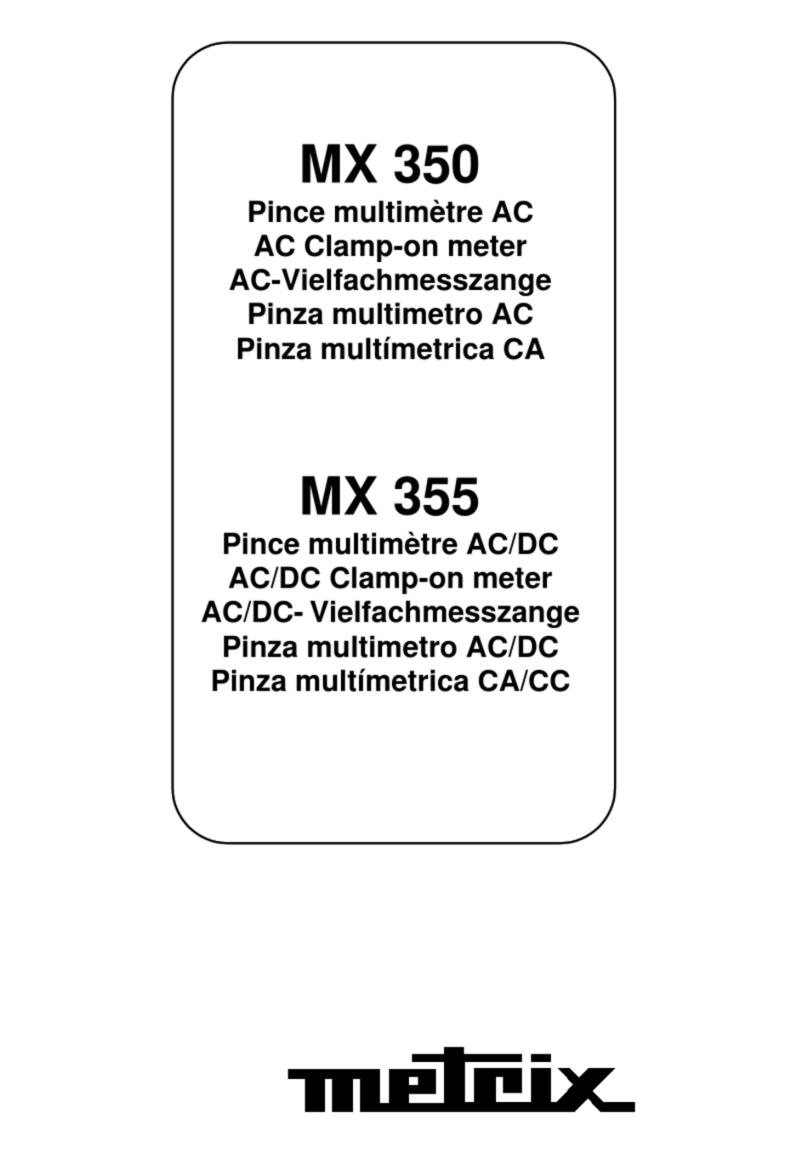
Metrix
Metrix MX 350 User manual
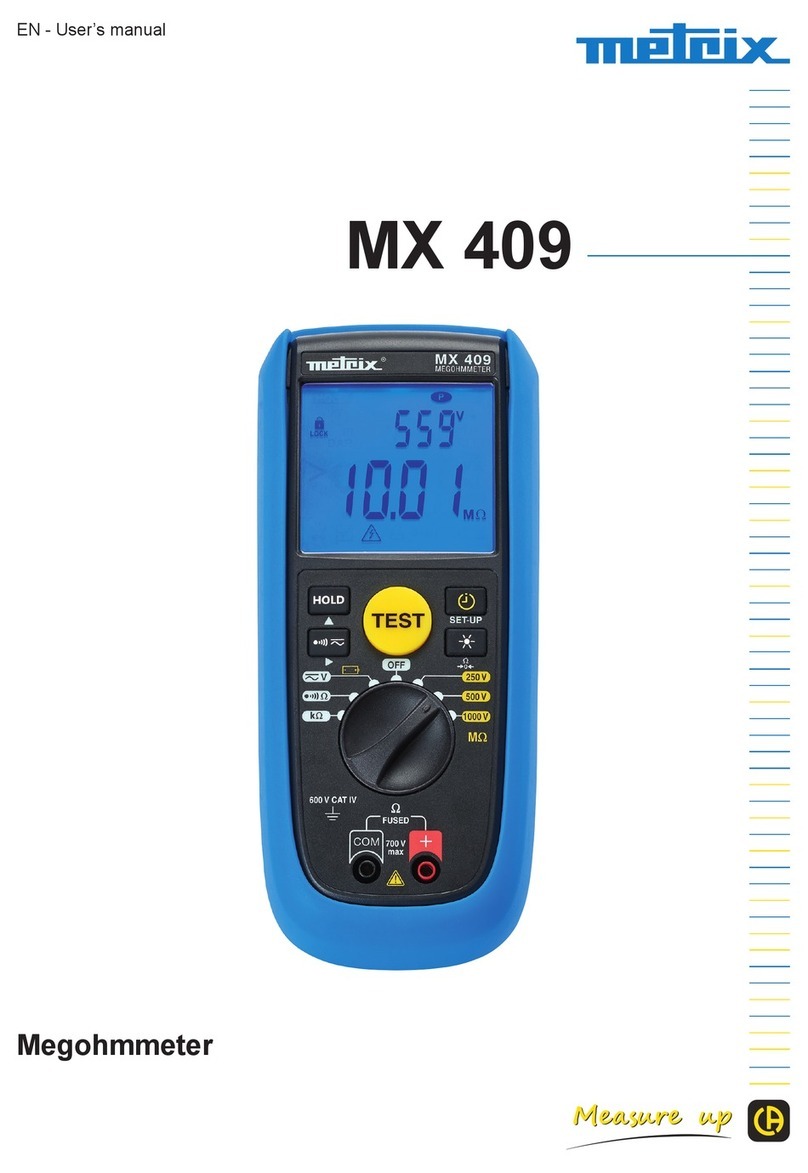
Metrix
Metrix MX 409 User manual
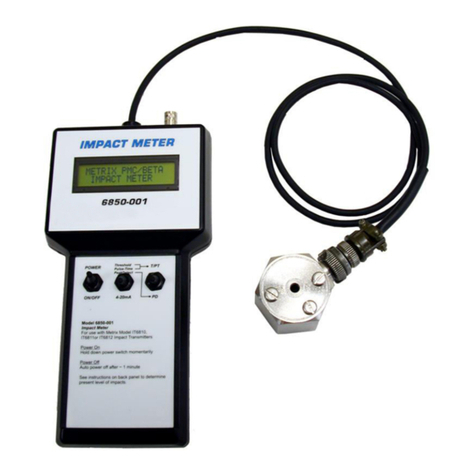
Metrix
Metrix 6850-001 User manual

Metrix
Metrix PX 110 User manual
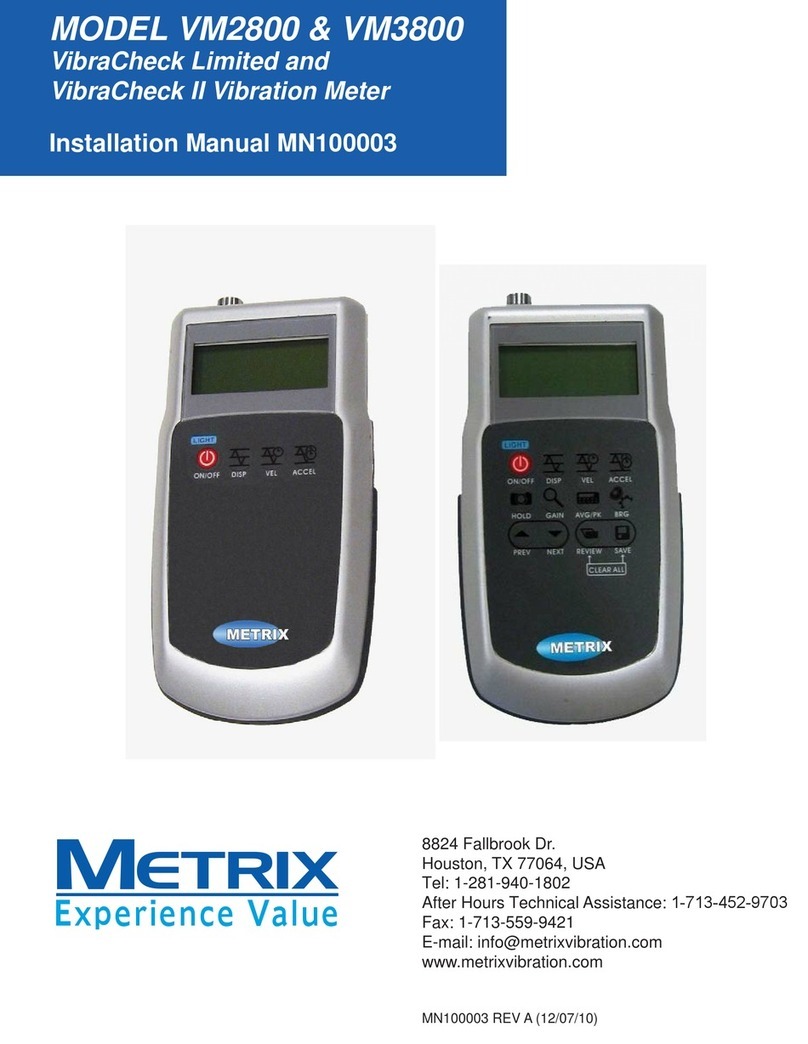
Metrix
Metrix VM2800 User manual
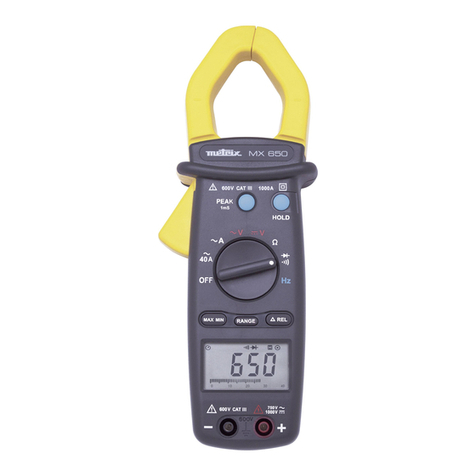
Metrix
Metrix MX 650 User manual
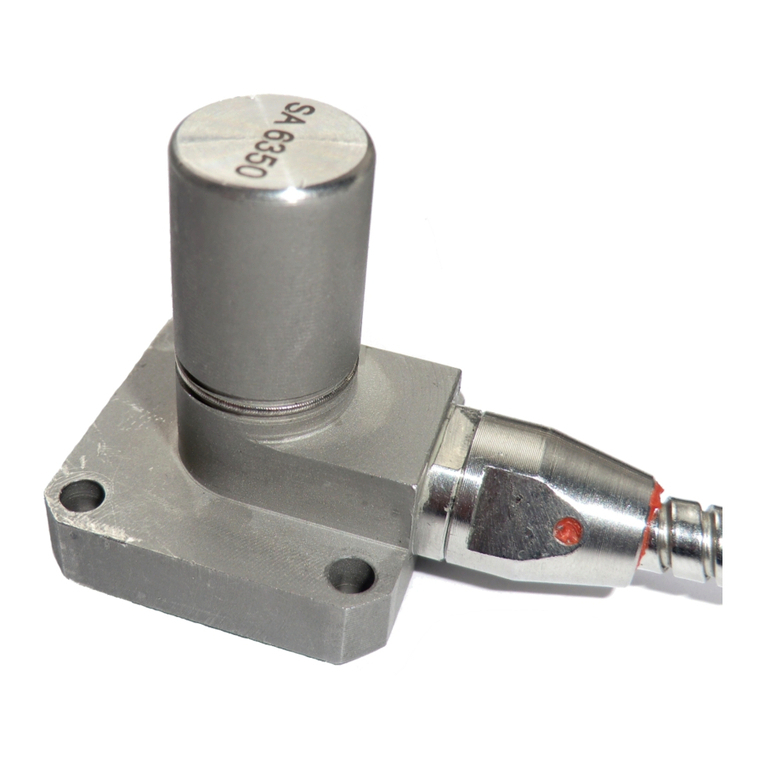
Metrix
Metrix SA6350 User manual
